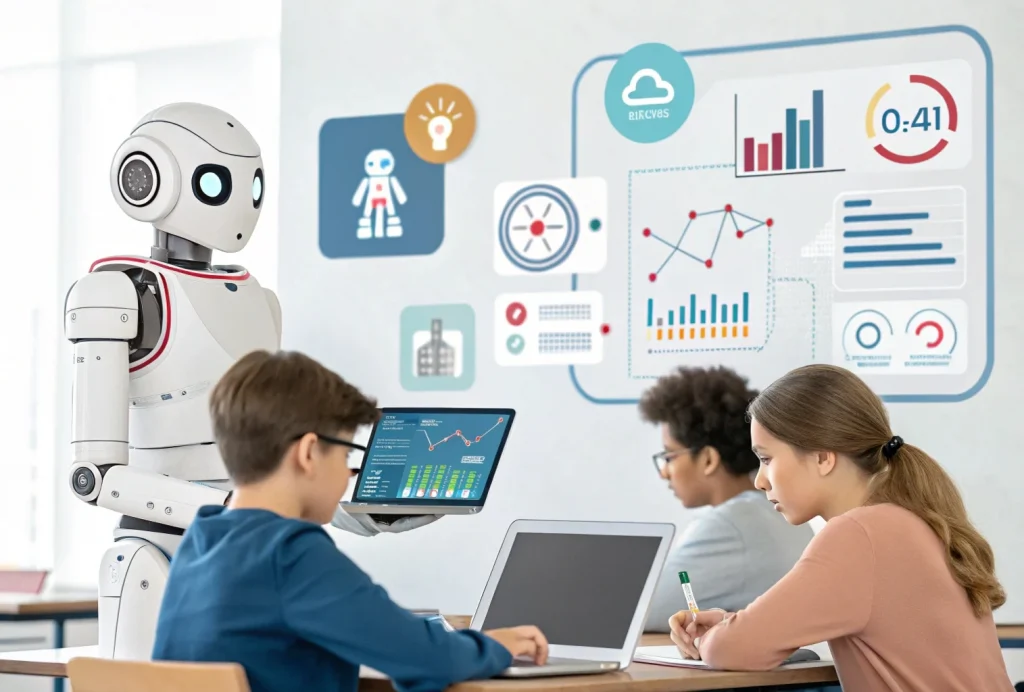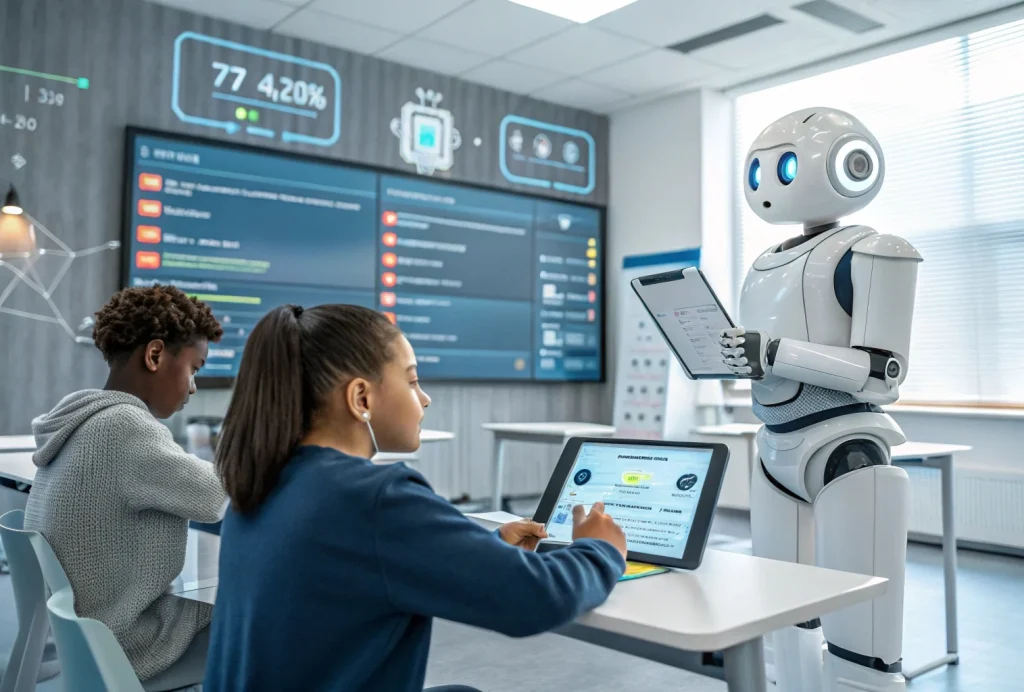Artificial Intelligence (AI) is changing the way we learn. In schools, colleges, and even online classrooms, AI tools are helping students learn better and faster. From smart apps that give instant feedback to systems that adjust lessons based on how a student performs, AI is making learning more personalized and engaging. The importance of AI in education is growing because it can help both students and teachers work more efficiently.
So why is everyone talking about AI in education? It’s because AI can solve many problems that schools face today—like large class sizes, limited resources, and the need for more personal attention for every student. In a country like India, where education needs to reach millions, AI offers smart and scalable solutions. In this blog, we’ll explore how AI is making education smarter, why it matters, and what it means for the future of learning.
The Current Role of AI in Education

Artificial Intelligence is already being used in many schools and online learning platforms to make education better. It is helping both students and teachers by making learning more flexible and efficient. Here are some key ways AI is currently being used in education.
| AI Application | Description | Key Benefit |
|---|---|---|
| Smart Tutoring Systems | Acts like a digital tutor by guiding students through lessons, giving instant feedback, and adjusting difficulty based on performance. | Helps students learn at their own pace with personalized support. |
| AI in Learning Management Systems (LMS) | Enhances online platforms by tracking student progress, identifying weak areas, and suggesting helpful content. | Saves teachers time and improves learning efficiency for students. |
| Personalized Learning Experiences | Studies each student’s learning style and offers customized lessons—such as videos, quizzes, or reading materials—based on their needs. | Makes learning more effective by catering to individual learning preferences and speeds. |
Benefits of AI in Education

AI brings many benefits to education that help both students and teachers. It not only improves how learning happens but also makes the process smoother and more effective.
| Benefit | Description | Impact |
|---|---|---|
| Tailored Learning Paths for Students | AI understands each student’s learning style and creates a custom path based on their strengths and weaknesses. | Helps students learn at their own pace and stay motivated. |
| Real-Time Performance Feedback | AI provides instant feedback on assignments and quizzes, helping students identify and correct mistakes immediately. | Improves understanding and speeds up the learning process. |
| Time-Saving Tools for Teachers | AI tools assist with grading, tracking progress, and suggesting teaching materials. | Reduces teacher workload and gives them more time to support students. |
| Accessibility and Inclusion for Diverse Learners | AI tools like voice-to-text and translation features help students with different learning needs or language backgrounds. | Makes learning more inclusive and supports equal opportunities for all students. |
The importance of AI in education is clear because it helps create a more personalized, inclusive, and efficient learning environment for everyone.
AI-Powered Tools Revolutionizing Classrooms

AI tools are making classrooms smarter by supporting both teaching and learning in exciting new ways. These tools are easy to use and help make learning more effective, fun, and personalized.
| AI Tool | Description | Impact on Education |
|---|---|---|
| Virtual Assistants and Chatbots | AI tools that answer questions, explain topics, send reminders, and offer 24/7 support to students. | Provides instant help, supports learning outside the classroom. |
| AI in Grading and Assessments | Automatically checks quizzes, short answers, and sometimes even essays, saving teachers time. | Speeds up grading and gives students faster feedback. |
| Adaptive Testing Platforms | Tests that adjust question difficulty based on how well a student is doing. | Creates personalized and stress-free testing experiences. |
| Language Learning Apps (Duolingo, Grammarly) | Uses AI to personalize lessons, correct grammar, and improve language skills in real-time. | Makes language learning more fun, engaging, and tailored to each student’s level. |
These tools show the importance of AI in education, as they make classrooms more interactive, reduce the burden on teachers, and give students the extra help they need to succeed.
Explore our online programs to become future-ready
Transform your career with industry-aligned courses designed by experts.
AI for Educators: Enhancing Teaching, Not Replacing
AI is not here to take over a teacher’s job—it’s here to support and improve how teachers work. By handling routine tasks and providing helpful insights, AI allows teachers to focus more on what matters most: teaching and connecting with students.
| AI Use in Education | Description | How It Helps Teachers |
|---|---|---|
| Automating Administrative Tasks | AI handles tasks like attendance, scheduling, and organizing student records. | Saves time and reduces workload, allowing teachers to focus more on teaching. |
| Intelligent Lesson Planning | AI suggests lesson plans and activities based on the curriculum and student performance data. | Helps teachers design better, more personalized lessons for their students. |
| Enhancing Teacher-Student Interaction Through Insights | AI tracks student performance and identifies areas where students are struggling or excelling. | Enables teachers to give targeted support and improve classroom engagement. |
These uses of AI show that its role is not to replace teachers, but to make their jobs easier and more impactful. The importance of AI in education also includes supporting teachers so they can provide better learning experiences for every student.
The Importance of AI in Remote & Hybrid Learning
The shift to online and hybrid learning—especially during the COVID-19 pandemic—showed how important technology has become in education. AI played a big role in helping students and teachers adjust to this new way of learning, and it continues to support digital classrooms today.
| Area of Impact | Description | How AI Helps |
|---|---|---|
| AI in E-learning Platforms During COVID-19 | During school closures, AI-powered platforms provided interactive lessons, quizzes, and feedback to keep learning going. | Helped track progress, offered instant feedback, and supported self-paced learning. |
| Bridging the Gap in Digital Education | Many students lack access to quality teachers or learning resources, especially in remote areas. | AI delivers high-quality, consistent content to students anywhere, making learning more equal. |
| Maintaining Student Engagement Remotely | Online classes can be hard to focus on. AI uses personalized content, reminders, and interactive tools to keep students interested and active. | Boosts motivation and keeps students engaged even when learning from home. |
Overall, the importance of AI in education became even clearer during remote and hybrid learning. It helped students stay connected, supported teachers, and made sure learning didn’t stop.
Challenges and Ethical Concerns
While AI brings many benefits to education, it also comes with some serious challenges. It’s important to be aware of these issues to use AI in a safe and fair way.
| Challenge | Description | Why It Matters |
|---|---|---|
| Data Privacy and Security | AI tools collect student data like grades and learning habits. If not protected, this data can be misused or stolen. | Student information must be kept safe to maintain trust and protect privacy. |
| Bias in Algorithms | If AI is trained on limited or biased data, it may give unfair results—favoring some students over others. | Can lead to unequal learning experiences and unfair treatment. |
| Dependence on Technology | Relying too much on AI can reduce human interaction and critical thinking in classrooms. | AI should support, not replace, real teaching and personal connection in learning. |
Understanding these challenges is important to ensure that the importance of AI in education is not limited by risks. With the right rules and careful use, we can get the best out of AI while keeping education safe and fair.
Future of AI in Education
As technology keeps improving, AI is expected to play an even bigger role in the future of education. It will not only make learning smarter but also help solve problems like dropouts and skill gaps.
| Future Use of AI | Description | Impact on Education |
|---|---|---|
| Predictive Analytics for Dropout Prevention | AI tracks student behavior, attendance, and grades to detect early signs of dropout risk. | Helps schools take early action to support students and reduce dropout rates. |
| AI-Led Lifelong Learning Platforms | AI platforms help people learn new skills throughout life by recommending courses and tracking progress. | Makes learning flexible and continuous, even after school or college. |
| Alignment with NEP 2020 and Global Reforms | AI supports personalized learning, skill development, and tech-based teaching, which are key goals of India’s NEP 2020 and global reforms. | Helps create modern, inclusive, and future-ready education systems worldwide. |
The importance of AI in education will only grow as schools and governments look for smarter, more effective ways to teach and learn in the years ahead.
Real-World Case Studies
To understand the importance of AI in education, it’s helpful to look at how it’s being used in real life. Countries around the world, including India, are already using AI to improve learning in schools and beyond.
India: AI in CBSE & EdTech Startups
In India, the Central Board of Secondary Education (CBSE) has started using AI to make learning more personalized. AI is being used to analyze student performance and suggest improvements. Many Indian EdTech startups like BYJU’S and Vedantu also use AI to offer customized lessons, practice tests, and instant feedback. These tools help students learn in a way that suits them best, no matter where they live.
Global: Use in Finland, China, and the US
Different countries are using AI in creative ways. In Finland, AI helps teachers track student progress and personalize learning. China uses facial recognition and smart classrooms to monitor student engagement and adjust teaching methods. In the United States, AI tools are used in schools and colleges for tutoring, grading, and creating individual learning plans. These examples show how AI is helping to create smarter, more student-friendly education systems around the world.
These real-world cases show that AI is not just a trend—it’s a global shift in how education works.
Conclusion
AI is changing education in powerful ways. From smart tutoring systems and personalized learning to helping teachers save time and supporting students with special needs, the importance of AI in education is more visible than ever. It’s helping make learning more flexible, fair, and focused on each student’s needs.
However, while AI brings many benefits, it’s also important to use it carefully. We must protect student data, avoid unfair bias, and make sure that technology supports teachers—not replaces them. When used the right way, AI has the potential to build a future where learning is easier, smarter, and more inclusive for everyone. The journey has already begun, and the future of education looks bright with AI by our side.


Leave a Reply